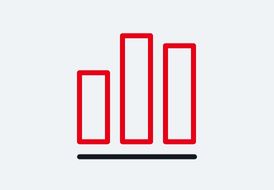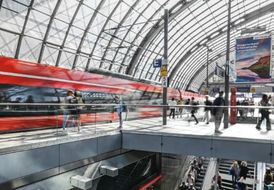European environment
DB Group
The European Fit for 55 package
On July 14, 2021, the European Commission submitted a comprehensive legislative package as part of its Green Deal (2021 Integrated Report).
The majority of the legislative package was negotiated with the trialogue agreement reached on an intensification of emissions trading of December 18, 2022. In future, emissions rights will be reduced even more. The existing free emissions certificates for air transport and industrial sectors that are particularly exposed to international competition are to be gradually removed. Shipping traffic is also to be included in emissions trading. From 2027, a new emissions trading system for buildings, road traffic and the use of fossil fuels in certain industrial sectors is to be created, similar to the German fuel emissions trading system. The income from the new emissions trading scheme is intended to finance a Social Climate Fund to support measures for more efficient buildings and lower-emissions mobility. Furthermore, the EU institutions agreed to no longer register new cars and light commercial vehicles that emit CO₂ in the EU from 2035 onwards.
Revision of the EU Directive on the certification of traction unit drivers
The European Commission is revising Directive 2007/59/EC on the certification of traction unit drivers. The proposal for an audit is expected to be available in the first half of 2023. The objectives of the revision of the Directive are to improve the mobility of traction unit drivers throughout the EU’s rail network and make it easier for employers to assign drivers to work in various member states.
After a comprehensive sector consultation in several stages (call for evidence in January 2022, public consultation in September 2022, expert interviews and hearings), the critical focal points of the revision were identified. At the moment, these are the requirements to be defined for language competence, the consideration to strive for a second, Europe-wide operating language, changes in the system of traction unit driver’s licence and additional certificates, which are kept separate today, as well as the plan to issue a regulation instead of a directive.
The European Greening Transport Package
By 2050, greenhouse gas emissions from transport are to be reduced by 90% compared with 1990. The European Commission is planning a comprehensive package of measures to make transport in Europe greener, which is expected to be presented in the second quarter of 2023. With direct relevance for rail, it is expected to include proposals for more efficient capacity and traffic management in cross-border rail transport, the revision of the Combined Transport Directive and the revision of the Directive containing maximum permitted dimensions and weights in road freight transport. In order to support these initiatives, a harmonized EU framework for calculating transport-related greenhouse gas emissions is to be implemented. The initiatives are outlined individually below.
Harmonized European Framework for recording and assessing transport-related greenhouse gas emissions (CountEmissions EU)
The initiative provided for under the Greening Transport Package is intended to apply both in passenger and freight transport and to provide transparent information that makes it possible to reduce and compare emissions. It should be a decision-making aid for users and citizens in order to choose the most sustainable means of transport and thus prevent potential greenwashing. Future eco-labeling should also be based on the system.
The European rail sector welcomes these plans. The methodology should be standardized, binding and possible to implement without great effort. The EcoPassenger and EcoTransIT World tools established in the transport sector have been used by DB Group for years. Both comply with the existing non-binding guidelines for the transport sector, standard EN 16258 for calculating and declaring greenhouse gas emissions. This standard is currently being revised and is to be elevated to an international standard as ISO 14083. This international standard would be an important step in laying the foundations for the “CountEmissions EU” initiative.
Infrastructure
Revision of the Regulation on EU guidelines for the expansion of the trans-European transport network
On December 14, 2021, the European Commission submitted a proposal to revise the Trans-European Transport Network (TEN-T) guidelines. The objective, as part of the European Green Deal, is to set the course for faster completion of the multimodal TEN-T core network by 2030 in particular, and the TEN-T comprehensive network by 2050 (2021 Integrated Report).
With the “extended TEN-T core network,” two new technical infrastructure parameters are to be implemented by 2040: a line speed of at least 160 km/h for most passenger transport lines and a loading gauge profile with a standard of at least P400 in rail freight transport/combined transport. The lauding gauge profile refers to standardized cross-sections of the infrastructure that ensure the space that must be left free for unrestricted passage of vehicles and loads with certain characteristics and dimensions. P400 is a profile that is suitable for 4 m tall semi-trailers. In view of the efficiency gains in links with the European rail freight transport corridors, the draft’s proposals include adjustments to governance. Under the Czech Presidency of the Council of the EU, the general approach was adopted at the beginning of December 2022 as a precondition for further negotiations with the EU Parliament and the Commission. The new network design proposed by the Committee with the target horizons of 2030/2040/2050 is essentially confirmed. At the same time, the compromise also sees the less stringent requirements when implementing the TEN-T infrastructure parameters compared with the Commission’s draft. Parallel negotiations in the Parliament are ongoing. The draft report was presented in October 2022. Once the TEN-T report has been issued, the negotiations to reach a compromise (trilogue negotiations) can begin. The TEN-T audit is expected to be completed no later than the second half of 2023. Against the backdrop of the war in Ukraine, on July 27, 2022, the European Commission accepted a delegate act to modify the proposed TEN-T regulation of December 14, 2021. This provides for changes to the width of the track (focus on new infrastructure, exceptions possible after cost-benefit analyses) to 1,435 mm and submission of a migration plan within two years; the deletion of Russia/Belarus from the indicative TEN-T maps; the downgrade of connections to Russia/Belarus (core network to the overall network) and an extension of four TEN-T corridors (North-Sea Baltic, Baltic, Black and Aegean Sea, Baltic Sea-Adriatic Sea and Rhine-Danube) in conjunction with solidarity lanes.
Freight transport
Revision of the Regulation concerning the creation of a European rail network for competitive freight transportder
The Regulation to create a European rail network for competitive freight transport, adopted in 2010, was the first instrument to improve the operation of the most important international railway lines for freight transport both within the EU and with third countries. Nine European rail freight corridors (RFC) were created to achieve this. Central sales structures, products and committee structures were also established to manage the corridors. A further two RFC were added in 2017 and 2018. Six of the now 11 European RFC run through Germany. The corridors are being developed further in order to implement the European Green Deal and the European Commission’s Sustainable and Smart Mobility Strategy. As part of the revision of the TEN-T guidelines, comprehensive proposals have already been submitted to amend the Regulation to establish a rail freight transport corridor. The aim is, among other things, to improve the governance of the rail freight transport corridors between member states, infrastructure operators and advisory groups (including train operating companies and terminal operators), as well as involving customers to a greater extent regarding infrastructure planning. The role of the European coordinator for transport corridors as an intermediary should also be strengthened. In 2022, the European Commission announced that it intends to submit an ambitious proposal for improved cross-border transport and capacity management as part of the Greening Transport Package, which will go beyond the rail freight transport market segment. Among other things, the European Commission would like to focus on operational aspects of rail freight transport. The European Commission is currently reviewing various optimization measures focusing on capacity management, performance, stakeholder management and the use of digital instruments. Stronger centralization at EU level is also to be examined.
Revision of the Weights and Dimensions Directive
As part of the Greening Transport Package, the European Commission plans to present the revision of the Directive “Setting the maximum permitted dimensions for road vehicles in national and cross-border traffic and establishing the maximum permitted weights in cross-border transport.” The use of zero-emissions vehicles with a maximum length of 25.25 m and a weight of 60 t in combined transport and, if applicable, approval of additional load capacities will be examined as part of a follow-up assessment. The European Commission would also like to assess a possible general increase in dimensions and weights and clearer or uniform requirements in cross-border deployments in connection with the impact on infrastructure and intermodal competition. From DB Group’s point of view, it is important to avoid effects that would lead to a return to road transport when adjusting the regulations.
Revision of the Combined Transport Directive
In the context of the Greening Transport Package, the European Commission is also simultaneously working on a revision of the “Directive on the establishment of common rules for certain types of combined transport of goods between member states” (Combined Transport Directive). The European Commission would like to focus on new approaches to eligibility, for example, which are intended to be oriented directly towards avoiding external costs. The extension of the term “combined transport” to now include multimodal transport chains, rather than just for container handling, is also to be examined. From DB Group’s point of view, a clearer definition of combined transport and its uniform design throughout Europe is essential. The promotion of smaller terminals that can be used for handling conventional and combined transport (“tiny terminals”) must also be considered. Existing privileges for combined transport must be maintained and it must be guaranteed that it predominantly takes place on the rails. Infrastructural requirements for terminals that provide for improved harmonization of technical standards within Europe are to be set within the revised TEN-T Regulation.


